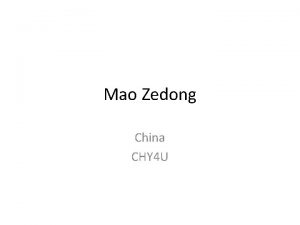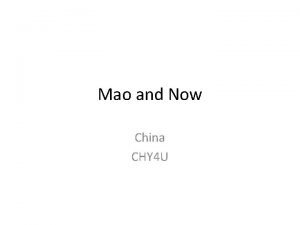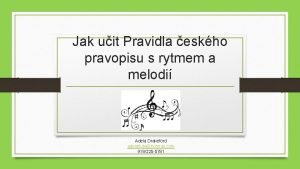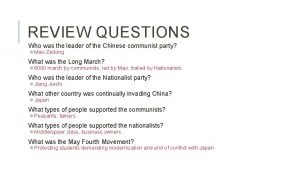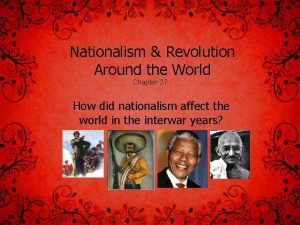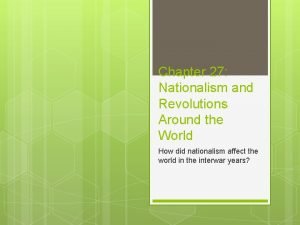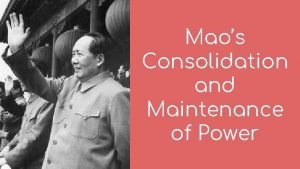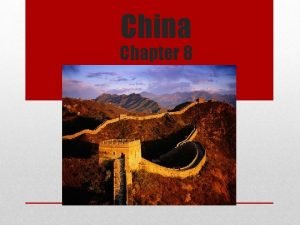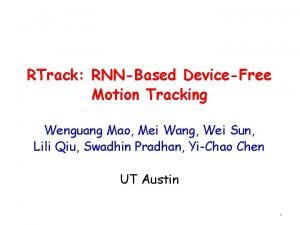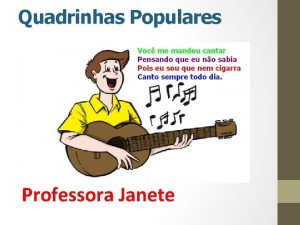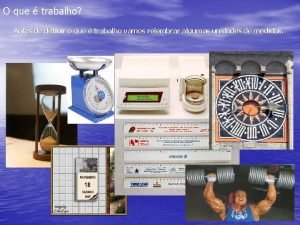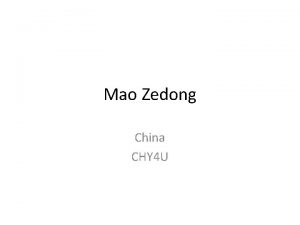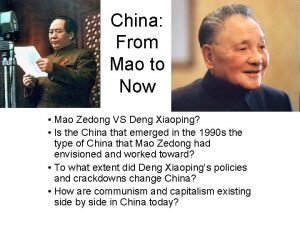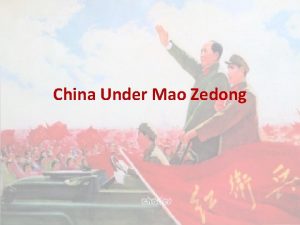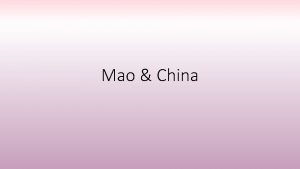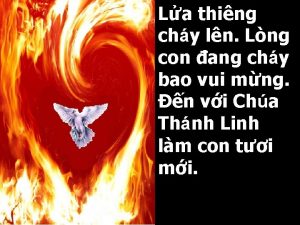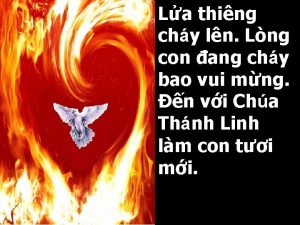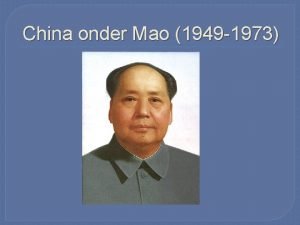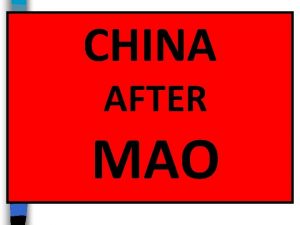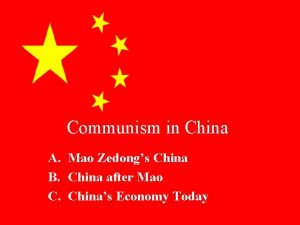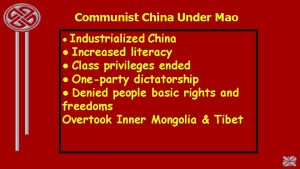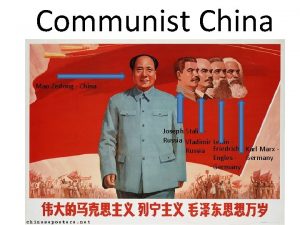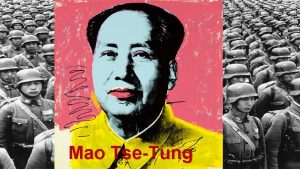Mao and Now China CHY 4 U Mao


















- Slides: 18

Mao and Now China CHY 4 U

Mao Zedong People’s Republic of China, 1949 -1976 Time Magazine, Feb. 7, 1949, 2013, http: //www. time. com/time/covers/0, 16641, 19490207, 00. html (May 27, 2013).

Massive Changes in Agriculture • Communes – Goal: industrialize agriculture • Commune = 2000 – 20 000 households • Proletarianization of the peasantry – No private property, no private market • Some peasants were diverted from agriculture to make steel for industrialization: backyard furnaces – Famine killed 27 -30 million people (people diverted from agriculture, food sent to cities)

Backyard furnaces at a Chinese commune in the late 1950 s https: //en. wikipedia. or g/wiki/Backyard_furnac e#/media/File: Backyard _furnace. jpg

1959 poster: “The commune is like a gigantic dragon, production is noticeable awe-inspiring. ” Chinese Posters. net, Great Leap Forward, March 2013, http: //chineseposters. net/themes/greatleap-forward. php (May 27, 2013).

Attempts at Industrialization • Great Leap Forward – Plan to increase the economy in 15 years to the level of advanced industrial nations like Britain – 5 -year plans • Nationalize all businesses, land, etc. • Build infrastructure, emphasize heavy industry (backyard furnaces) • Fed by the communes – food sent to cities (another contributor to artificial famine)

1958 poster: note the backyard furnaces in the back left. Ibid.

Opposition • After 1949, 20 million landlords (often KMT supporters), rich peasants, counterrevolutionaries were sent to prisons and labour camps • Note: KMT leadership fled to Taiwan, continued the Republic of China • Only one political party allowed - Communists

THE CULTURAL REVOLUTION

Criticize the old world and build a new world with “Mao Zedong Thought” as a weapon, 1966. Chineseposters. net, Cultural Revolution, Aug. 2013,

Oppose economism: destroy the new counteroffensive of the capitalist class reactionary line, 1967. Ibid. , http: //chineseposters. net/gallery/e 12 -610. php

Foreshadowing “A revolution is not a dinner party, or writing an essay, or painting a picture, or doing embroidery; it cannot be so refined, so leisurely and gentle, so temperate, kind, courteous, restrained, and magnanimous. A revolution is an insurrection, an act of violence by which one class overthrows another. ” – Mao Zedong, 1927. Quoted in David Pietrusza, The Chinese Cultural Revolution (San Diego: Lucent Books, 1997), 16.

Enemy People and Things • Traditional culture (e. g. , Peking Opera, Confucian values) • Western people and things (diplomats attacked, jam, coffee, street names associated with imperialism) • Teachers attacked by their students • Old things (e. g, museums) Carma Hinton, A Visual and Visceral Connection to the Cultural Revolution, The Neiman Foundation for Journalism at Harvard, Neiman Reports, Spring 2004, http: //www. nieman. harvard. edu/reports /article/100890/A-Visual-and-Visceral. Connection-to-the-Cultural. Revolution. aspx (May 27, 2013). In 1966 these Fransiscan nuns who had run an English school where diplomats’ kids attended were denounced and eventually deported.

Destroying old objects, 1966. “Art and China’s Revolution” at Asia Society, New York Times, 2013, http: //www. nytimes. com/slideshow/2008/09/05/arts/20080905 -REVO_3. html (May 27, 2013).

BUILDING TODAY’S CHINA

Opening Up After the Cultural Revolution Dan La Botz, China: From Bureaucratic Communism to Bureaucratic Capitalism, New Politics, Nov. 20, 2012, http: //newpol. org/content/china-bureaucratic-communism-bureaucratic-capitalism (Jan. 21, 2014).

Deng Xiaoping • “To get rich is glorious. ” • “Socialism with a Chinese face. ” Theodore M. White, Time Magazine, Banishing Mao’s Ghost, Burnout of a Revolution, Sept. 26, 1983, 2014, http: //content. time. com/time/magazine/article/0, 9171, 949845, 00. html (Jan. 21, 2014).

4 Modernizations 1. Massive industrialization (introduction of capitalism in the economy) 2. Closing of communes – boost agriculture 3. Defense 4. Technology
 Chy china
Chy china Chy china
Chy china Hy chy ky ry dy ty ny básnička
Hy chy ky ry dy ty ny básnička Hy chy ky ry dy ty ny na zdi visí hodiny
Hy chy ky ry dy ty ny na zdi visí hodiny Dvouhlásky
Dvouhlásky Mao mao
Mao mao When did mao take over china
When did mao take over china When did mao take over china
When did mao take over china Now i see it now you don't
Now i see it now you don't Mao consolidation and maintenance of power
Mao consolidation and maintenance of power Sun yat sen and mao zedong
Sun yat sen and mao zedong The lake isle of innisfree william butler yeats
The lake isle of innisfree william butler yeats History of tao te ching
History of tao te ching Wenguang mao
Wenguang mao Quadrinhas populares exemplos
Quadrinhas populares exemplos Potential fields
Potential fields Carrinho de mao inter resistente
Carrinho de mao inter resistente Mao
Mao Mao's domestic policies
Mao's domestic policies
